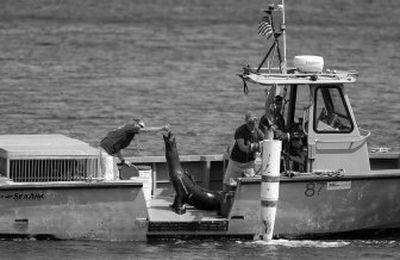Spies undercover, underwater

SEATTLE – Eager to bolster security around a Trident submarine base, the Navy wants to use dolphins and sea lions in Pacific Northwest waters – a proposal that was shut down nearly 20 years ago.
The mammals are just one of the alternatives being considered for Naval Base Kitsap at Bangor, but they’ve generated the most interest and outcry in recent months as the Navy seeks public comment on its plan. Dolphins, with their unparalleled sonar abilities, and sea lions, with excellent underwater hearing and sight, can be trained to locate mines or underwater intruders.
“People are fascinated by the animals,” said Mark Xitco, senior scientist with the Navy Marine Mammal program in San Diego. “That’s been true since the program started almost 50 years ago.”
Critics are concerned about the environment’s potential impact on the creatures. The cool Pacific Northwest waters pose a threat to Atlantic bottlenose dolphins, they say.
They point to the deaths earlier this year of several dolphins that washed ashore in Texas. Officials with the Galveston-based Texas Marine Mammal Stranding Network said the mammals probably became ill in reaction to colder water during winter months.
Janet Bailey, a retired wildlife rehabilitator from Bainbridge Island, has urged the Navy to adopt an alternative that would not endanger any other species.
“They could do better than dolphins,” she said.
Bailey founded Knitting for Dolphins, a loosely formed group with chapters in California, Florida and Washington that hopes to at least draw attention to the issue.
At a recent public meeting on the proposal hosted by the Navy in Seattle, Bailey sat with her glasses perched at the tip of her nose, knitting the beginning of a deep blue dolphin sweater. The yarn had already taken the shape of a dolphin’s tail fin.
“The more public attention is paid to the project then the more pressure will be upon them either to do it right or not to do it at all,” she said.
Toni Frohoff, a dolphin biologist from Bainbridge Island and volunteer consultant with Knitting for Dolphins, said that even though the dolphins may survive the change of climate, that doesn’t mean “the dolphin could not be suffering regularly and intensely.”
For the Navy, the concept of increasing security is fairly simple, especially on land. Build a fence, restrict access, put some sensors out there. When there’s an intruder, you can apprehend him and figure out what his intentions are.
“Underwater, or on the waterfront, it’s a completely different proposition. We don’t live in the underwater environment, we don’t have very good senses down there, so for humans it’s a very difficult thing to understand,” said Cmdr. Jon Wood, commanding officer of Naval Special Clearance Team 1 in San Diego, which uses human divers, dolphins and remotely operated vehicles to detect, locate and destroy sea mines.
The Navy’s goal is to deter people from being somewhere they’re not supposed to be.
The Navy already uses dolphins for security at a submarine base at Kings Bay, Ga. They were used to protect ships in Bahrain as recently as September 2005, ammunition in Vietnam in 1970-71, and they were deployed nightly along the coastline during the 1996 Republican National Convention in San Diego, said Tom LaPuzza, program spokesman.
Xitco said that in the history of the program, about a dozen or so animals have failed to return for a variety of reasons, including some that joined wild animals and one sea lion that was eaten by a shark.
“In hundreds of thousands of opportunities for the animals to potentially choose another way of life, at astonishingly high rates, they choose to return home to us and their companions,” he said.
Of the proposals for Bangor, dolphins and sea lions are the most efficient at detecting people and determining their threat level, Wood said.
Dolphin sonar is unmatched by any manmade technology, he said. And sea lions have sensitive directional hearing and vision suited to low light levels.
Wood said remote-operated vehicles aren’t as successful as dolphins or sea lions. The technology, even when teamed with underwater sensor grids, isn’t capable of recognizing the difference between a person, fish or killer whale, for example.
Another concept is to use combat swimmers, but “there’s a whole bunch of problems in that,” he said, noting the difficulty for humans to see or hear underwater.
Instead, the Navy would like to use dolphins and sea lions it says have already proved their capabilities.
“My unit has deployed animals in America, overseas, cold water, warm water and the animals have been very successful,” said Wood, who contends the dolphins have no problems working in colder waters.
Early research and development led to today’s fielded marine mammal systems, which use animals, personnel and special equipment to perform jobs too difficult for divers or technology not yet advanced enough to carry out such underwater missions.
Today, the marine mammal program uses 75 dolphins and 30 sea lions and has a team of more than 100 animal care professionals, including nine veterinarians, seven veterinarian technologists, undergraduate volunteers and other researchers from around the nation.
“They’ve been tested continuously over more than 30 years on Navy exercises worldwide and have deployed to operational combat both in Vietnam and the Middle East, and been highly successful,” Xitco said.
This isn’t the first time a marine mammal system has been proposed for additional security in the Northwest.
In 1989, the Navy wanted to deploy marine animals to the region, but a federal judge sided with animal welfare activists concerned about the effects of cooler water – a difference of about 10 degrees from San Diego waters – as well as how the creatures would affect the environment.
The Navy has hired a marine mammal physiologist to research those effects. The findings will be part of an environmental impact report expected by summer 2008.